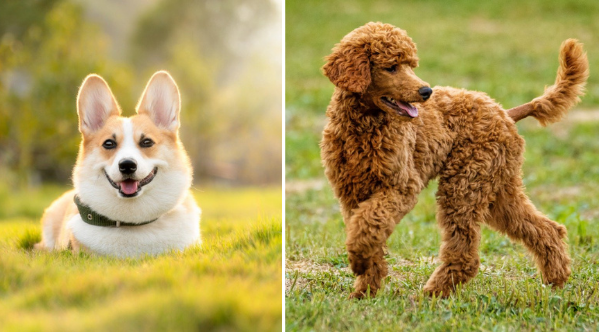The Charm of Corgi Ears: An Insight into their Size and Position

You've seen them everywhere - those adorable little furry beings with their perky ears that seem to radiate charm and cuteness. Yes, we're talking about corgis!
But have you ever wondered why their ears are the way they are? In 'The Charm of Corgi Ears: an Insight Into Their Size and Position,' we'll delve into the fascinating world of corgi ears and uncover the secrets behind their size and position.
From their historical significance to the science behind their unique shape, we'll explore it all. So, get ready to embark on a journey that will not only deepen your understanding of corgi ears but also help you appreciate the safety and care these adorable creatures deserve.
Let's embrace the charm of corgi ears together!
The History of Corgi Ears
Corgi ears have a rich history that dates back centuries, captivating dog enthusiasts with their distinctive shape and position. These adorable floppy ears hold both evolutionary significance and cultural symbolism.
Evolutionarily, the size and position of Corgi ears have played a crucial role in their survival. Their large, upright ears allowed them to hear predators approaching and helped them navigate their surroundings with precision.
Culturally, Corgi ears have become iconic symbols of cuteness and charm. Their unique shape and position have captured the hearts of people around the world, making them popular as pets and in various forms of media.
Understanding Corgi Ear Size
To understand the unique charm of Corgi ears, it's important to delve into the intricacies of their size and how it contributes to their overall appearance.
Corgi ear health is crucial, as proper care ensures they remain in good condition. The size of a Corgi's ears can vary, with some individuals having larger ears that stand upright, while others have smaller ears that fold forward.
The size of the ears can affect the aesthetics of the Corgi's face, giving them a distinct and adorable look. It's important to note that ear size alone doesn't determine a Corgi's health or breed standard.
However, maintaining good corgi ear health is essential to prevent any potential issues and keep their ears looking their best.
Factors Affecting Corgi Ear Position
Understanding the factors that influence the position of a Corgi's ears can provide insights into their unique charm and appearance.
When it comes to corgi ear genetics, it's important to note that the position of their ears is determined by their genes. Some corgis may have ears that stand up straight, while others may have ears that flop over. This variation adds to their adorable and distinctive look.
However, it's also crucial to consider corgi ear health. Keeping your corgi's ears clean and free from infections can help maintain their proper position. Regularly check for any signs of redness, discharge, or foul odor, as these could indicate an ear infection.
The Science Behind Corgi Ears
Now, let's delve into the fascinating science behind those adorable Corgi ears.
One aspect to explore is the evolution of their ear structure, which has adapted over time to enhance their hearing capabilities. By comparing their hearing abilities to other dog breeds, we can gain a deeper understanding of why Corgis have such unique and charming ears.
Ear Structure Evolution
Explore the fascinating evolution of corgi ears and learn how their unique structure has developed over time.
The evolution of corgi ears can be attributed to a combination of factors, including ear development and genetic variations.
Through the process of natural selection, corgis with certain ear structures were more likely to survive and reproduce, leading to the gradual development of their characteristic ears.
Genetic variations played a crucial role in this evolution, as they allowed for the expression of different ear shapes and sizes.
Over time, corgis with ears that were more conducive to their environment, such as being pointed or floppy, had an advantage and passed on these traits to future generations.
The result is the adorable and unmistakable ears that we see on corgis today.
Hearing Capabilities Comparison
Through the process of natural selection, corgis have developed unique ear structures that not only contribute to their adorable appearance but also play a crucial role in their exceptional hearing capabilities. Corgi ear anatomy is specifically designed to enhance their ability to detect sounds, making them excellent companions in various environments.
Here's a comparison of their hearing capabilities:
- Size and Position: Corgi ears are medium-sized, erect, and positioned high on their heads. This allows them to catch sound waves more effectively and accurately.
- Range: Corgis have a wider range of audible frequencies compared to humans. They can detect sounds at both higher and lower frequencies, making them more aware of their surroundings.
- Sensitivity: Corgi ears are highly sensitive to subtle noises. They can pick up faint sounds, alerting you to potential dangers or intruders.
- Directional Hearing: The shape and position of their ears allow corgis to determine the source of a sound more precisely. This helps them locate prey, communicate with their humans, and stay safe.
Understanding corgi ear anatomy and taking care of their ear health is essential to maintain their hearing capabilities. Regular check-ups and proper cleaning can prevent infections and ensure their ears remain in top condition.
Corgi Ears and Communication
As an owner, you may notice that the size and position of your corgi's ears play a significant role in their communication. Understanding your corgi's ear expressions is crucial for ensuring their well-being and safety.
Corgi ear health is essential, as infections or injuries can cause discomfort and hinder their ability to communicate effectively. When your corgi's ears are erect and facing forward, they're likely alert and attentive. On the other hand, if their ears are pinned back against their head, it could indicate fear, anxiety, or submission.
Caring for Corgi Ears
To properly care for your corgi's ears, it's important to regularly clean and inspect them for any signs of infection or injury. Here are a few essential steps to ensure your furry friend's ears stay healthy and infection-free:
- Gently clean their ears: Use a veterinarian-approved ear cleaning solution and a cotton ball to wipe away any dirt or debris from the ear canal. Be careful not to insert anything deep into the ear to avoid causing damage.
- Check for redness or swelling: Regularly inspect your corgi's ears for any signs of inflammation, redness, or swelling. These could be indications of an ear infection or injury and should be addressed promptly.
- Dry their ears thoroughly: After bathing or swimming, make sure to dry your corgi's ears thoroughly. Moisture trapped in the ear canal can create a breeding ground for bacteria and lead to infections.
- Avoid excessive hair in the ears: Corgis have floppy ears, which can trap hair and increase the risk of infections. Regularly trim the hair around the ears to prevent this from happening.
Embracing the Charm of Corgi Ears
You can't help but fall in love with the adorable charm of corgi ears. They're one of the most endearing features of these lovable dogs. Corgi ears come in different sizes and positions, adding to their unique appeal. But it's not just their cuteness that makes corgi ears special, they also require proper grooming and care to ensure their health.
Corgi ear grooming is an essential part of their overall hygiene routine. Regularly cleaning their ears helps prevent the buildup of dirt, wax, and bacteria that can lead to infections. Use a gentle cleanser and cotton balls to gently wipe the inside of their ears, being careful not to go too deep. It's also important to check for any signs of redness, swelling, or discharge, as these can be indications of an ear infection.
Maintaining corgi ear health also involves regular inspection. Look out for any signs of discomfort, such as excessive scratching or shaking of the head. If you notice any unusual symptoms, it's best to consult a veterinarian for further evaluation.
Embrace the charm of corgi ears by giving them the love and attention they deserve. By practicing proper corgi ear grooming and staying vigilant about their health, you can ensure that their ears remain as adorable as ever. Remember, a happy and healthy corgi is an even more charming companion.











